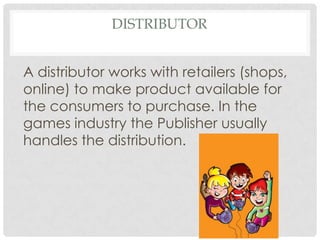The games industry- Industry Structure
- 1. THE GAMES INDUSTRY INDUSTRY STRUCTURE
- 2. INTRODUCTION • The games industry, once a niche form of interactive entertainment often dismissed as being for children or teenage boys, is now a multi-billion pound industry that rivals the film industry in terms of revenue and prestige.
- 3. INTRODUCTION • Gaming was perceived as having ‘hobby culture’ (created by enthusiasts rather than big business) as recently as the 1970s so this is relatively young industry and the way it functions is constantly changing.
- 4. INTRODUCTION • The main reason for this is due to it being a technology led industry, and as software and hardware develops so does the framework around which games are created, sold and consumed.
- 5. INSTITUTIONS The games industry is made up of the following institutions: Developer - Publisher – Distributor – Hardware – Consumer
- 6. PUBLISHERS These are companies that are responsible for the marketing and distribution of the game.
- 7. DISTRIBUTOR A distributor works with retailers (shops, online) to make product available for the consumers to purchase. In the games industry the Publisher usually handles the distribution.
- 8. HARDWARE MANUFACTURERS While developers create software, other companies create the hardware that the games run on. In the games industry the major players are Microsoft, Sony and Nintendo who make the Xbox 360, PlayStation 3 and Wii respectively. There are, however, many other types of hardware apart from consoles on which games can be played such as PC, phones and handhelds (DS, PSP).
- 9. CONSUMER • Or ‘the audience’ - anyone that buys, plays, downloads games.
- 10. STRUCTURE • Basic illustration of how the videogames industry functions and the process in which games go from ‘concept to consumption’: • Developer - Publisher – Marketer- Distributor – Hardware -Retail– Consumer
- 11. HOWEVER……. • Because of new technology, convergence and new ways of distribution the development of concept to consumption has changed • E.G. developer-Facebook-Consumer
- 12. PAIRED ACTIVITY/FEEDBACK • Research into two games! • One which fits into the traditional model of concept to consumption and one which fits into the new model of concept to consumption • Using your notes describe the process of the game from development to consumerism! • Who is the developer? What stages were taken for the game to reach its audience? What is the revenue of the game? Where can you play the game? Etc….











